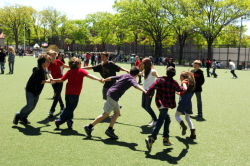Washington Park
The Old Stone House
The Old Stone House, also known as the Vechte-Courtelyou House, is a replica of a Dutch stone farmhouse that had a rich history. The original house was built by Claes Arentson Vechte, a Dutch immigrant, beside Gowanus Creek in 1699. Its two-foot thick wall of fieldstone and brick and its heavily shuttered windows protected the family. The Vechtes prospered, farming the rich bottomland beneath the Heights of Guam (the hills of Park Slope), harvesting oysters in Gowanus Creek (now Gowanus Canal), and ferrying produce to market in Manhattan. At the time, this area was part of the village of Gowanus in the old Town of Breukelen.
During the Battle of Brooklyn, Long Island, August 27, 1776, the sturdy house and its strategic position made it the focus of the most dramatic event of the day. The house was held by an estimated 2000 British and hired Hessian soldiers, who turned it into an artillery position. From the house, they fired on the Americans, who had suffered disastrous losses and were fleeing for their lives to the safety of American forts across the Gowanus Creek. Against this stronghold, some 400 of the Maryland Brigade threw themselves in six attacks, regained the house twice, but, ultimately, were repulsed. Nevertheless, it was their valor, witnessed by General Washington and his troops, that hardened the resolve of the American Army. That day, close to three quarters of the brave Marylanders made the ultimate sacrifice.
Nicholas Vechte, grandson of Claes, was still living at the Old Stone House during the Revolutionary War. Like other local farmers, he faced harsh conditions under the British occupation. Upon his death in 1779, the farm was willed to his grandson, Nicholas R. Cowenhoven, a minor at the time who probably did not live there. In 1797 Cowenhoven sold the house to Jacques Cortelyou, who purchased it for the use of his newly married son, Peter. Peter’s son Jacques inherited the house in 1815 and his was the last family to reside in the Old Stone House.
After the death of his wife, Jacques Cortelyou sold the property to Edwin Litchfield, a railroad developer, in 1852. The house remained standing another forty years. It was occupied by an African-American caretaker, then used as a clubhouse for a skating club in the winter and a baseball club in the summer. The Old Stone House became the first clubhouse of the Brooklyn team of the National Base Ball league, later known as the Brooklyn Dodgers.
When street grading raised the level of Fourth and Fifth Avenues, only the second story of the house was above ground level. In 1897 the exposed part of the house was razed in a public demonstration of military technology and then buried. The Brooklyn Parks Department acquired the site in 1926 and excavated the house in 1930. Reconstruction of the building was completed in 1934 using the original stones. However, the new park house was turned 90 degrees and placed a few feet further west and sixteen feet higher than the original farmhouse. The house underwent restoration in the 1970s and the 1990s.
Today this replica of the Old Stone House is dedicated to increasing public awareness of the Old Stone House as an icon of American History. The Old Stone House Historic Interpretive Center is operated by the First Battle Revival Alliance, named in honor of that "first battle" of the newly formed country against Great Britain, the 1776 Battle of Brooklyn. The organization studies, publicizes, and preserves the heritage of the site through exhibits and through school and public programs.
Check out your park's Vital Signs
Clean & Safe
Green & Resilient
Empowered & Engaged Users
Share your feedback or learn more about how this park is part of a
Vital Park System

